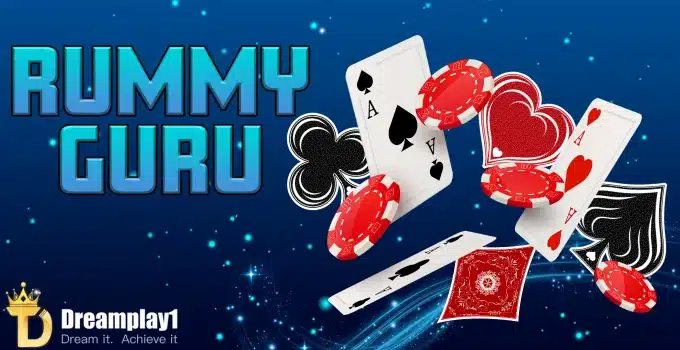
Rummy Guru, a classic card game revered by many across the globe, is not just about the luck of the draw but also about the strategies you employ and the skills you develop. Whether seated around a cozy table with friends or facing opponents in an online arena, mastering Rummy is both an art and a science. But how does one transition from being a casual player to a pro? I can help you rephrase the text you provided. Here it is:
Get ready to become a Rummy expert with our comprehensive guide, filled with proven tactics and detailed instructions that have been approved by the Rummy Guru.
This guide is curated to provide players of all levels, from beginners to seasoned enthusiasts, with tools, tactics, and insights that can elevate their Game. Dive in to discover the Game’s secrets, understand its intricacies, and embark on your journey to becoming a Rummy Guru.
History of Rummy
With its intricate melds and captivating strategies, Rummy has roots far back in history. Yet, its exact origins remain debated among historians and card enthusiasts alike.
- Ancient Beginnings: Some theories suggest that Rummy Guru originates in China, tracing back to the Game of ‘Mahjong’ and a card game called ‘Khanhoo.’ Others believe it evolved from the Spanish card game ‘Conquian,’ which involves the melding of cards, a core aspect of Rummy Guru.
- European Influence: By the 18th century, card games with mechanics similar to Rummy Guru began appearing in Europe. The play ‘Rum,’ which shares several similarities with modern Rummy, gained popularity in Britain and other parts of Europe. The naming might have been influenced by the term ‘Rum Poker,’ suggesting a combination of both card games.
- American Evolution: Rummy saw significant development in America during the 19th century. It’s believed that the Game, arriving via immigrants and traders, quickly gained traction in the New World. The early 20th century marked the emergence of ‘Gin Rummy,’ a variant that has since become a staple in card game circles. Its creation is credited to Elwood T. Baker and his son C. Graham Baker, who devised the Game as a faster-paced version of the standard Rummy.
- Global Spread and Modern Variants: The 20th century saw Rummy variants populating card tables worldwide. Each region introduced its unique twist, leading to many versions like Indian Rummy Guru, Kalooki, and Canasta. These versions often reflect the cultural nuances and preferences of their regions.
- Digital Era Transition: With the advent of the internet, Rummy made a seamless online transition accessible to millions worldwide. Online platforms enabled players to experience various Rummy versions, participate in tournaments, and even receive tutelage under Rummy gurus. The digital era preserved the Game’s legacy and expanded its reach to newer, younger audiences.
In essence, the history of Rummy is a testament to its enduring appeal and adaptability. From ancient card tables to digital platforms, the Game has consistently evolved, ensuring its place in the hearts of car enthusiasts for generations.
Basic Rules and Gameplay of Rummy
In its many forms, Rummy Guru has foundational rules that form the Game’s core. The primary goal is to create sets and runs from the cards dealt to you. Here’s a distilled guide to the basic rules and gameplay:
The Deck and Cards
Standard Rummy uses a deck of 52 cards. Depending on the variant, one or two decks might be used, sometimes with jokers.
Cards have values:
- The point value of face cards (K, Q, J) is 10.
- Aces are worth 1 point.
- Numbered cards are worth their face value.
Dealing the Cards
A predetermined number of cards are distributed to every player from a deck that has been shuffled. In a two-player game, ten cards are dealt to each player. The remaining cards form the stockpile.
The top card from the stock is placed face up next to it, starting the discard pile.
The objective of the Game
Players must form valid combinations of cards in their hands.
- Sets: Three or four cards of the same rank but different suits. For example, 7♣ 7♠ 7♦.
- Runs: At least three cards of the same suit arranged in consecutive order. For example, 4♠ 5♠ 6♠.
Gameplay Mechanics:
- Draw: Start your turn by taking a card from the stockpile or the discard pile.
- Meld: Organize cards into sets or runs.
- Discard: End your turn by placing a card onto the discard pile. This strategy helps reduce the point value of your unarranged cards.
Ending the Game:
There are two possible ways in which the Game may come to an end.
- A player forms valid sets/runs for all cards in their hand (except one final discard) and declares, laying out their cards for verification.
- The stockpile runs out of cards. In some variants, this results in a drawn game, or specific rules may come into play.
Scoring:
After a player declares, others reveal their cards and calculate the value of unarranged cards. Lower scores are better.
In some variants, bonus points are awarded for specific configurations or Game winning.
Winning:
The winner is the player with the lowest total score at the end of a predetermined number of rounds or games. In some versions, the winner of that round is the first to declare.
While the essence of Rummy remains consistent, the diverse Game variants introduce unique rules and twists. Players are encouraged to familiarize themselves with the specific regulations of the Rummy Guru version they’re playing.
Rummy Guru Strategies
The true essence of Rummy goes beyond the basic rules—it lies in the strategies one employs to outsmart opponents. Learning from Rummy gurus can offer insights that can dramatically transform your Game. Here are some advanced methods that Rummy maestros often use:
Starting Hand Strategy:
- Evaluate Quickly: Assess your hand immediately after receiving your cards. Check if you’re closer to a pure sequence, which is crucial for reducing your points.
- Prioritize Sequences: Always create at least one pure sequence before moving to other combinations. Without a pure line, even a zero-point hand can lead to a total 80/100 points based on your playing variant.
Discard Strategy:
- Mislead Opponents: Occasionally discard a card that suggests you’re forming a particular sequence or set, only to go in a different direction.
- High-Value Cards: If they aren’t part of a probable set or sequence, discard high-value cards early to minimize points in hand. However, be wary, as intelligent opponents can use this to their advantage.
- Watch Opponents’ Picks: Be attentive to the cards opponents pick and discard. This will help in predicting their potential sets and sequences.
Drawing Strategy:
- Deck vs. Discard: While picking from the discard pile is tempting because it’s a known card, be cautious. This gives away a hint to your opponents about the sets or sequences you’re trying to form.
- Joker Utilization: Jokers are invaluable. Remember not to waste them in a pure line, while they should be used to form impure sequences or sets. Also, avoid using high-point cards with Jokers; utilize them in other settings or arrangements.
Endgame Tactics:
- Keep Options Open: As the Game progresses, aim to have cards that can be melded in multiple ways. This flexibility can be the difference between declaring and waiting another turn.
- Race to Finish: As one approaches a potential finish, it might be wise to speed up the Game by drawing from the discard pile, even if it reveals your strategy.
- Hold onto Key Cards: If you suspect an opponent is waiting for a particular card to finish their set/sequence, hold onto it for as long as possible without jeopardizing your position.
Psychological Play:
- Change Tactics: If you sense opponents have caught onto your strategy, be prepared to switch tactics mid-game.
- Observe Behavior: In offline games, observing physical tells can be helpful. Online, note the speed of decision-making, which might indicate the strength of an opponent’s hand.
Preparation and Adaptability:
- Stay Updated: Like all games, Rummy Guru strategies evolve. Regularly updating your knowledge, perhaps from a Rummy guru or community forums, can provide new insights.
- Adapt to Your Opponents: Every player has a unique style. Some might be aggressive, while others play safe. Adapting your strategy based on your opponent’s gameplay can be crucial.
- Practice and a thorough comprehension of the intricacies of the Game are necessary to implement these approaches effectively. Mastering these tactics with time, persistence, and a guru’s insights will become second nature, edging you closer to becoming a Rummy Pro.

Common Mistakes in Rummy Guru and How to Avoid Them
Even seasoned players can sometimes fall prey to common missteps in Rummy. Recognizing these mistakes and sidestepping them can significantly enhance your gameplay. Here’s a compilation of frequent errors and strategies to avoid them:
Not Arranging Cards Properly:
- Mistake: Keeping cards jumbled makes visualizing potential sets or sequences hard.
- Solution: Always arrange your cards from low to high and group them according to potential sets or sequences. Use alternate colors to distinguish between different suits for clarity.
Ignoring the Pure Sequence:
- Mistake: Focusing on sets or other sequences before ensuring a pure line.
- Solution: Always prioritize forming at least one pure sequence early in the Game. Without it, you risk accumulating maximum points if an opponent declares.
Holding onto High-Value Cards:
- Mistake: Keeping high-value cards shorter, hoping to form a set or sequence.
- Solution: If high-value cards like King, Queen, or Jack aren’t part of a probable sequence or set, discard them early to minimize potential points.
Tips from Top Rummy Gurus
Drawing from the wisdom of renowned Rummy Guru experts, these tips encapsulate years of experience and astute gameplay. Here’s what the best in the business advise:
Practice Regularly:
Just as with any skill, practice is crucial. The more hands you play, the better you quickly evaluate your cards and predict opponents’ moves.
Stay Updated on the Rules:
Even if you think you know the Game inside out, always brush up on rules, especially if you’re venturing into different Rummy variants.
Develop a Flexible Strategy:
Don’t get stuck on a single strategy for every Game. Rummy situations vary, and so should your approach. Adapt based on your hand and your observations of other players.
Observe and Learn:
Watching others, especially those better than you, can be a goldmine of information. Note their strategies, their discards, and their play tempo.
Control Your Emotions:
Rummy is as much a psychological game as it is about skill. Gurus emphasize the importance of a poker face and not letting disappointments or successes show.
Conclusion
Rummy Guru, a game interwoven with skill, strategy, and a sprinkle of luck, has captivated the minds of players worldwide. Its allure lies not just in the rules or the play but in the profound depths of strategy one can explore. Drawing from the wisdom of Rummy Guru, we’ve delved into advanced tactics, sidestepped common pitfalls, and unearthed tips that can transform an amateur into an adept player.
However, the essence of the Game goes beyond just strategies. It’s about the camaraderie shared around the table, the thrill of the draw, the suspense of every discard, and the jubilation of a well-played win. The road to mastering Rummy is paved with continuous learning, adaptability, and, most importantly, a passion for the Game.

